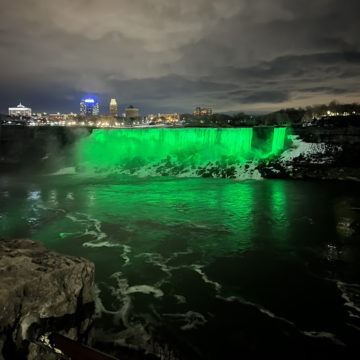by Ethan Seavey

The extant Kin of the Colonizer are paralyzed but that doesn’t stop them from running their mouths. They yap and yell and are filled with angst and guilt. Their rage fuels something, but that rage is only easy to find when they are pinned up against that Last True American Colonialist. Otherwise they surround themselves with each other and in there it is hard to be mad.
They hop in a rental car and they cross fields of naked-armed trees talking about that mythical land that once existed, before this one had paved it over. How beautiful New York state must have once been, before there were cameras to capture it. They cross the border into Canada and talk borders, how wide and unmanageable, how purposefully desolate, how torturous to cross without a white face. Their white lips talk of white powers and their pink tongues get lost and meander in circles. They ask if Canada is any “better” than the US and they see parallels but such vast differences that the question asked in the first place is deemed irrelevant.
At Niagara Falls they are like everyone else. They watch the falls in mostly silence. They take pictures and selfies. They walk up the cement pathway slowly and turn around every few steps. Again they talk about how it used to be. A sacred site for hundreds of years before white settlers. Then, a spiritual experience for earlier white settlers. They talk about how it is now: a strip of skyscraping hotels towering high over the wonder, dwarfing its excellence in order to give a white man in a business suit a better view. They notice the cemented pathways and the bridges spanning and the boats crossing and the people crowding and the spirit fading or already gone. They find the road lined with ferris wheels and go-carts and haunted houses and kitschy white nostalgia.
At the Royal Museum of Ontario the Kin of the Colonizer revel in the extensive artwork of Kent Monkman and his god(dess) Miss Chief Eagle Testickle. Canada elevates Indigenous voices! Canada is that imaginary land where a genderqueer beauty of the Fisher Creek Cree nation can display such vibrant and violent indignation.
On their way out of the same museum they descend a staircase encircling a ceremonial pole of the Nisga’a people and grimace when they read the plaque: joined the museums’ collection in 192(x). Bought by the museum long before the artists were recognized as human, to be held in large white hands.
It is Saint Patrick’s Day and they talk Irish colonization. They talk about the fluctuation of the Irish race, which was not-white not so long ago, but which is just white now. For hundreds of years Ireland was treated some sort of ancient prototype of colonialism and it only recently ended and it actually never ended and it continues today. How the white faces of the English looked at the white faces of their neighbors and found ways to degrade their humanity. A rough cloth exposing tiny abrasions where dehumanization can settle and infect. They listen to the dark Irish songs, those Mary Black and Sinéad O’Connor.
Aren’t there more happy songs? Surely there are more happy songs.
They don’t wear enough green and they overthink it. They make an effort to find an Irish pub and they succeed but the line is very long. They enjoy the high spirits of those in line excited to drink to be drunk. Under hushed voices they discuss the implications of Irish alcoholism, the potential result of generations of economic and social stress. They talk stereotypes and how the Irish were deemed lazy during the famine which was only a famine because the Irish weren’t allowed to eat all of the food that they were growing for England. They talk about how the Irish were commanded to build walls to nowhere to fix their laziness. Inside the bar live music plays. Maybe the band is Irish. The music is not Irish, but covers of American artists and one of Avicii. At the end of the line they don’t want to pay the $20 cover fee and so they walk off.
The Kin of the Colonizer are Nicaraguan and Mexican and Spanish. They are Irish and British. They are Catholic and Jewish. Their conflicting identities boil up inside themselves. It hurts to talk but they learned that it is healing to speak with one another. They learn about the systems that led to their existence in order to disrupt them.
At the end of the weekend they cross the border back into America. They drive back on long paved roads, spanning dormant and snowy hills. As they arrive in Jersey they regard the fragile marshlands just off the highway. They say that they had no idea such wetlands existed so close to Manhattan. Of course they know that Manhattan was once like this: one of the most ecologically diverse areas, crucial to the health of the land and the sea; yes, here was once Manahatta. But it is not conceivable to see the yellow grass lit up under golden setting sun, not here, where everything is paved and nothing is left.
